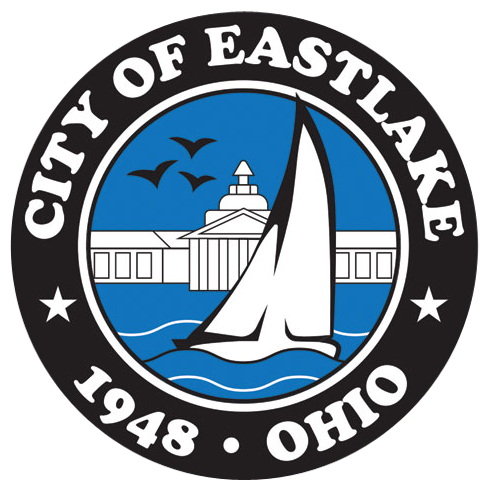The Early History of Eastlake, Ohio
In early times, all of northern Ohio belonged to the Erie Indians. The Eries are probably related to the Iroquois. It is not known whether they are descended from, or ancestor of, that nation. Erie territory extended from New York’s Genesee River across northern Ohio to the Miami River.
The Eries named out river “Sha-ga-rin” or “Shaguin,” meaning “clear water.” Their game, the elk, were good engineers and made our first roads. Their trails followed the easiest grade.
The Evans map of 1755 (pdf) shows the predominance of elk in our region, calling the Chagrin river “Biche,” which is the French word for “elk.” To the French, the Erie were the “Nation du Chat” or the “Cat Nation.” They revered the lynx, or the eastern wild cat.
The Reeve village site of the Eries, located on a bluff 1/4 mile south of the mouth of the Chagrin, was first visited by Charles Whittlesey in 1877. It originally consisted of two walls of earth. The bluff was about 35 feet high, and on the east side of the river, Reeve village was dug and mapped by the Ohio State Archeological and Historical Society in 1929.
A reminder of our Indian ancestry is the name of “Lost Nation Road.” There are many stories of the origin of this name, so this will be multiple choice: (1) Indians escaping from a battle that took place at the intersection of the “Salt Trail” (River Road) and the “Flint Trail” (Euclid Avenue) in downtown Willoughby skipped town in canoes they had anchored in the river, and became the Lost Nation. (2) The folks living here were isolated by weather conditions, therefore, cut off from civilization, they become a lost nation. (3) Early settlers, having lost their own stills, were rowdy and boisterous, but preferred to be a lost nation.
Early Settlers
In 1797 David Abbot, the first permanent white settler in this township, received a grant from the Connecticut Land Company. It included land adjacent to the east and west sides of the river. For the site of Abbot’s first grist mill there are as many locations as there are authors. The best evidence places it in 1798 at the intersection of the northeastern channel (known then as the Elk River) with the west branch of the Chagrin. High water here forced Abbot, in 1803, to rebuild about two miles up the river near the ford at Erie and Pelton.
Early history of Eastlake, OhioAnother enterprise of Mr. Abbot was the building of the schooner “Cuyahoga Packet” on the Chagrin in 1805. David Abbot had sold his mills and property and moved with his family to Milan in 1810.
John and Catharine Miller were among the first settlers, coming here in 1801. Samual Miller, their son, was the first white child born in the settlement, and his pale face stood out among the papooses along the southern shore of Lake Erie.

 She was born Martha J. Montgomery on Feb 13, 1928, in Terre Haute, Indiana, to Milton and Meta (Mayfield) Montgomery. She had two brothers and four sisters. The family relocated to the west Cleveland area in 1939. After graduating from John Marshall High School in 1946, she attended St. Alexis School of Nursing, graduating in 1949. The nursing school was very strict. The girls could not be married. One girl married just before graduation and they expelled her from the school with no diploma. Although the student nurses were in their twenties they had a 9:50 curfew. The school was a very affordable way for a young lady to have a career. As an RN the nurses were taught to stand if a doctor was about and to treat them in a respectful manner. Their hair could not rest on their shoulders and for this reason many had short hair cuts. Receiving a nurse’s cap was part of the graduation process. They had to be kept clean. They were starched cleaned at the Chinese laundry. (Nurses have since forgone the wearing of the cap.) The nurses wore white nylon stockings with white starched uniforms and white oxford shoes with a little heel.
She was born Martha J. Montgomery on Feb 13, 1928, in Terre Haute, Indiana, to Milton and Meta (Mayfield) Montgomery. She had two brothers and four sisters. The family relocated to the west Cleveland area in 1939. After graduating from John Marshall High School in 1946, she attended St. Alexis School of Nursing, graduating in 1949. The nursing school was very strict. The girls could not be married. One girl married just before graduation and they expelled her from the school with no diploma. Although the student nurses were in their twenties they had a 9:50 curfew. The school was a very affordable way for a young lady to have a career. As an RN the nurses were taught to stand if a doctor was about and to treat them in a respectful manner. Their hair could not rest on their shoulders and for this reason many had short hair cuts. Receiving a nurse’s cap was part of the graduation process. They had to be kept clean. They were starched cleaned at the Chinese laundry. (Nurses have since forgone the wearing of the cap.) The nurses wore white nylon stockings with white starched uniforms and white oxford shoes with a little heel.